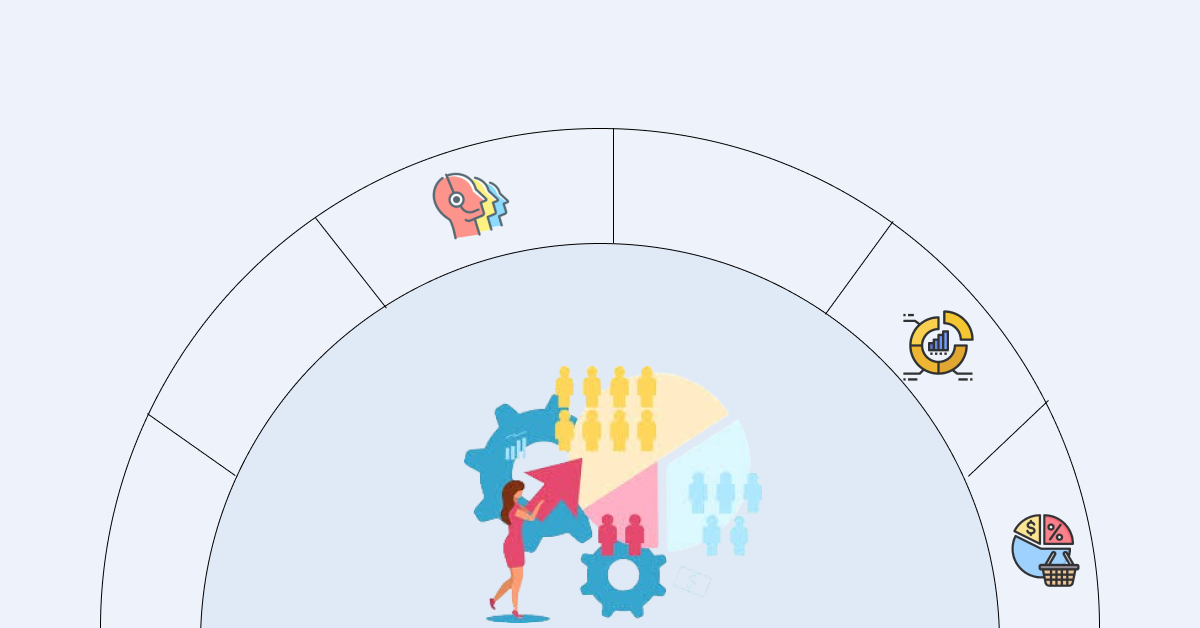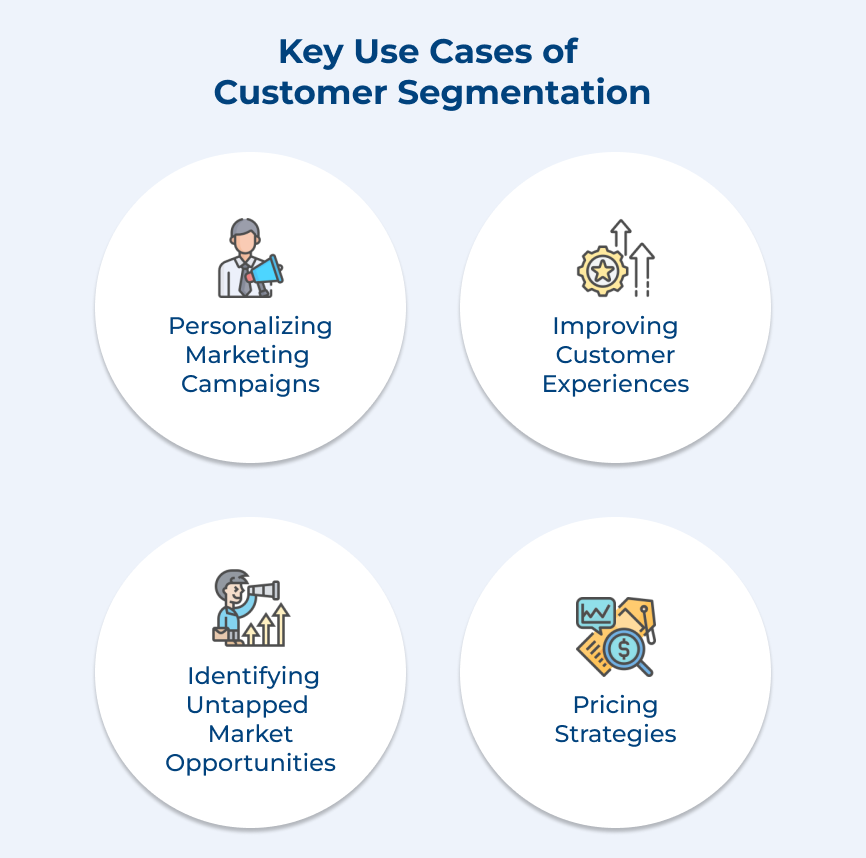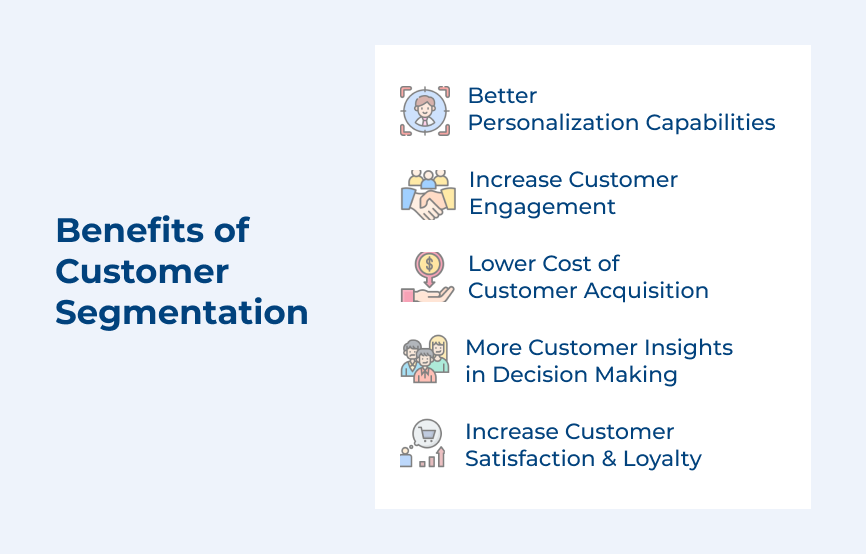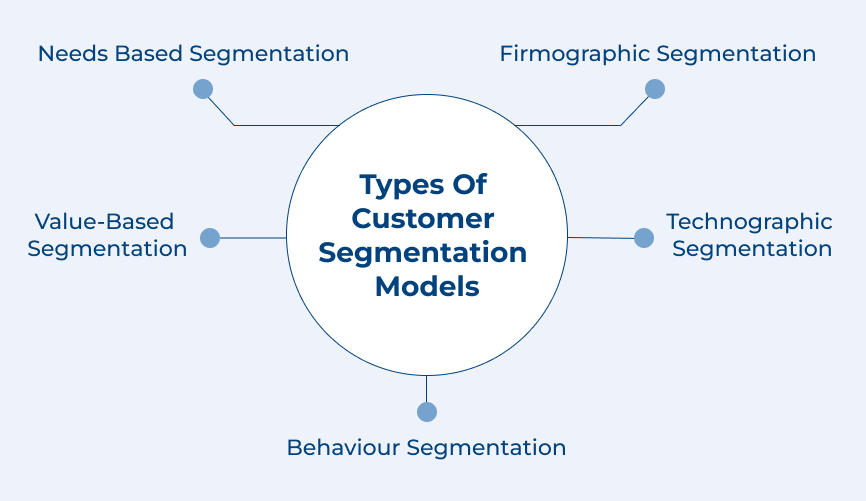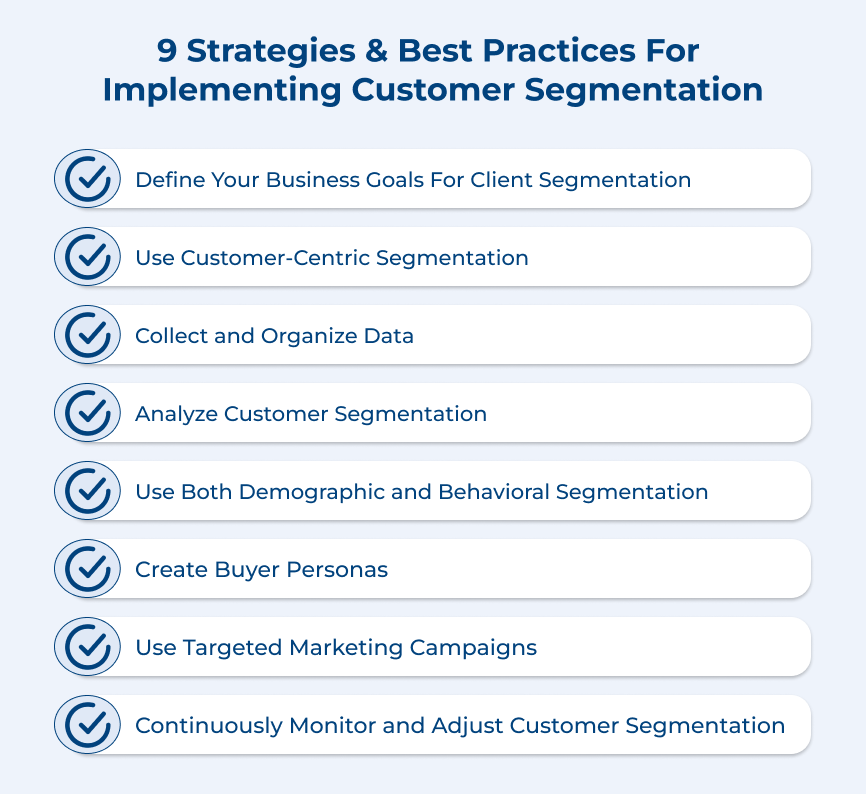1. Define Your Business Goals for Client Segmentation
The first step towards client segmentation is to define your business goals. The goals should align with your overall business strategy. Customer segmentation in marketing should be viewed as a tool to achieve these goals. Let’s say business goals may include increasing sales, improving customer retention or targeting a new market segment. Once you have identified your goals, you can then create customer segments that align with these goals.
Best Practices:
- Review your business objectives to ensure that they are realistic and achievable.
- Identify the metrics that you will use to measure the success of your customer segmentation strategy.
- Use customer feedback to validate the business goals and ensure that they meet your customers’ needs.
2. Use Customer-Centric Segmentation
Customer-centric segmentation involves grouping customers based on their needs and preferences. The approach recognizes that customers have different motivations for purchasing products or services, so they need to be treated differently. Let’s assume a clothing retailer segments customers based on style preferences or size requirements. Businesses can ensure that their product offerings and marketing efforts are tailored to each segment’s needs.
Best Practices:
- Collect customer data through surveys, customer feedback, or transaction history, and use this data to create customer profiles.
- Develop customer personas that represent each segment, including their buying preferences, interests, and motivations.
- Use qualitative and quantitative data to validate the accuracy of your customer personas regularly.
3. Prioritize Segments Based on Their Value
Businesses should prioritize their customer segments based on their value to the organization. High-value customers who make frequent purchases and generate the most revenue should be given the most attention. Prioritizing segments allows businesses to focus their marketing efforts and resources on the segments that have the most significant impact on their bottom line.
Best Practices:
- Use data analysis to identify the most profitable customer segments.
- Develop customer segments that align with your business goals and include high-value customers.
- Allocate resources based on the value of each segment, focusing on the segments that have the most significant impact on the business.
4. Collect and Organize Data
The success of customer segmentation depends on the quality of the data collected. Businesses must collect data from various sources including customer feedback, surveys, transaction history and social media to organize it in a meaningful way. Collecting and organizing data helps businesses develop accurate customer segments.
Best Practices:
- Use a customer relationship management (CRM) system to collect and organize customer data.
- Collect data from multiple sources including social media, customer feedback and transaction history.
- Regularly update your customer data to ensure that it is accurate and relevant.
5. Analyze Customer Segmentation
User segmentation analysis involves using data analysis to develop customer segments. Businesses can identify patterns and trends that can inform their segmentation strategy. Customer segmentation analysis should be an ongoing process, as customer behavior and preferences may change over time.
Best Practices:
- Use data analysis tools to identify patterns and trends in customer data.
- Test your segmentation strategy to identify areas for improvement and optimization.
- Regularly evaluate the effectiveness of your segmentation strategy and adjust it as needed.
6. Use Both Demographic and Behavioral Segmentation
Businesses should use both demographic and behavioral segmentation to create accurate customer segments. Demographic segmentation involves grouping customers based on their demographic characteristics, such as age, gender, income and education level. Behavioral segmentation categorizes customers based on their behavior, such as their purchasing habits, preferences, and interests.
Best Practices:
- Develop customer segments based on both demographic and behavioral characteristics.
- Use data analysis to identify patterns or trends in customer behavior and demographics.
- Regularly update your customer segments to ensure that they remain accurate and relevant.
7. Create Buyer Personas
Buyer personas are fictionalized representations of your ideal customer segments. They include details about the customer’s demographics, behavior, interests, needs, and pain points. Creating buyer personas allows businesses to understand their customers better and tailor their marketing efforts to meet their needs.
Best Practices for Implementing this Strategy:
- Create buyer personas based on data analysis, customer feedback, and market research.
- Use customer feedback to validate the accuracy of your buyer personas.
- Continuously update your buyer personas as customer behavior and preferences change.
8. Use Targeted Marketing Campaigns
Once you have developed customer segments, you can use targeted marketing campaigns to reach each segment with tailored content and messages. Targeted marketing campaigns are a cost-effective way to increase engagement and conversions by speaking directly to the interests of each segment.
Best Practices:
- Develop marketing campaigns that are tailored to each customer segment.
- Use the right channels to reach each segment, such as social media, email marketing, or direct mail.
- Use data analysis to measure the effectiveness of your marketing campaigns and optimize them as needed.
9. Continuously Monitor and Adjust Customer Segmentation
Customer segmentation should be viewed as an ongoing process rather than a one-time event. Businesses should continuously adjust their segmentation strategy based on customer feedback, behavior changes and market trends. You can ensure that your marketing efforts remain relevant, engaging, and effective.
Best Practices:
- Continuously collect and analyze customer data to identify changes in behavior or preferences.
- Test and optimize your segmentation strategy regularly.
- Regularly solicit customer feedback to validate the accuracy and relevance of your segmentation strategy.
Customer Segmentation Examples
Let’s go through the customer segmentation examples that demonstrate how strategic grouping can transform your marketing efforts and lead to greater overall success.
Amazon
Amazon is arguably the king of customer segmentation, with its massive database of customer preferences and behavior that feeds its highly personalized marketing campaigns. The company tracks every customer’s browsing or purchase history, search queries and even mouse movements to create targeted recommendations.
Geographic segmentation is crucial for Amazon’s global reach. It customizes shipping options, languages and even content recommendations based on geographic location. It uses behavioral segmentation to analyze customer activity, allowing Amazon to offer personalized suggestions and exclusive deals. The impact of segmentation on Amazon’s success cannot be overstated. It enables the company to target specific audiences with relevant marketing campaigns, boosting customer engagement and satisfaction.
Marriott
Marriott International is a hospitality company that has a diverse set of customer segments, from leisure travelers to business professionals. The company uses a combination of demographic, geographic and psychographic data to tailor its services to each segment.
Marriott follows a multi-faceted approach to customer segmentation. They classify their customers based on various factors such as demographics (age, gender, income), psychographics (lifestyle, values, interests) and behavior (frequent traveler, business traveler, leisure traveler). It allows Marriott to tailor their marketing efforts and services to meet the unique demands of each segment.
The impact of customer segmentation on Marriott is significant. It enables them to deliver personalized experiences, whether it’s through targeted email campaigns, tailored loyalty programs or customized stay packages. Understanding the needs of different segments allows Marriott to effectively allocate resources, enhance customer satisfaction and drive customer revenue growth.
Dropbox
Dropbox is a cloud storage and file-sharing platform that has made customer segmentation a key part of its growth strategy. The company has multiple customer segments, including students, freelancers and enterprise clients. They created targeted marketing campaigns for each segment.
The impact of segmentation in Dropbox has been significant. Understanding the different requirements of individual users and businesses allowed Dropbox to provide customized solutions to each segment. It has not only led to increased customer satisfaction but also boosted customer loyalty and retention.
Johnson & Johnson
Johnson & Johnson is a healthcare company that has implemented customer segmentation to improve its patient-centric approach. The company has segmented its patient base into different health conditions and stages. They provide targeted support and education for each group.
Johnson & Johnson focuses on demographics, psychographics, and behavioral factors. They have identified different target groups such as families with young children, aging populations and healthcare professionals. Understanding the unique needs and preferences of each segment has enabled Johnson & Johnson to create tailored marketing campaigns, develop new products and deliver personalized customer experiences.
One major impact of customer segmentation at Johnson & Johnson is improved marketing effectiveness. Targeting specific segments has enabled the company to allocate resources efficiently and reach its intended audience with relevant messages. It contributes to increased customer satisfaction and loyalty.
Getting Started with Consumer Segmentation
Customer segmentation is a vital tool for businesses to extract valuable insights from their customer base. Dividing customers into distinct groups based on factors like demographics, psychographics and behavior allows businesses to personalize their offerings for each segment’s unique needs.
A robust segmentation model enables businesses to identify their ideal customers, profitable customers and prospective customers. It makes it easier to target marketing efforts and improve customer acquisition.
Key Takeaways:
- Customer segmentation is an effective way to personalize offerings for each customer segment’s unique needs, driving higher engagement and revenue.
- A robust model helps businesses identify their ideal customers, profitable customers, and prospective customers, enabling them to target marketing efforts more effectively.
- The analysis provides valuable insights into customer behavior and preferences. It makes it easier for businesses to improve the customer experience and drive customer acquisition.
